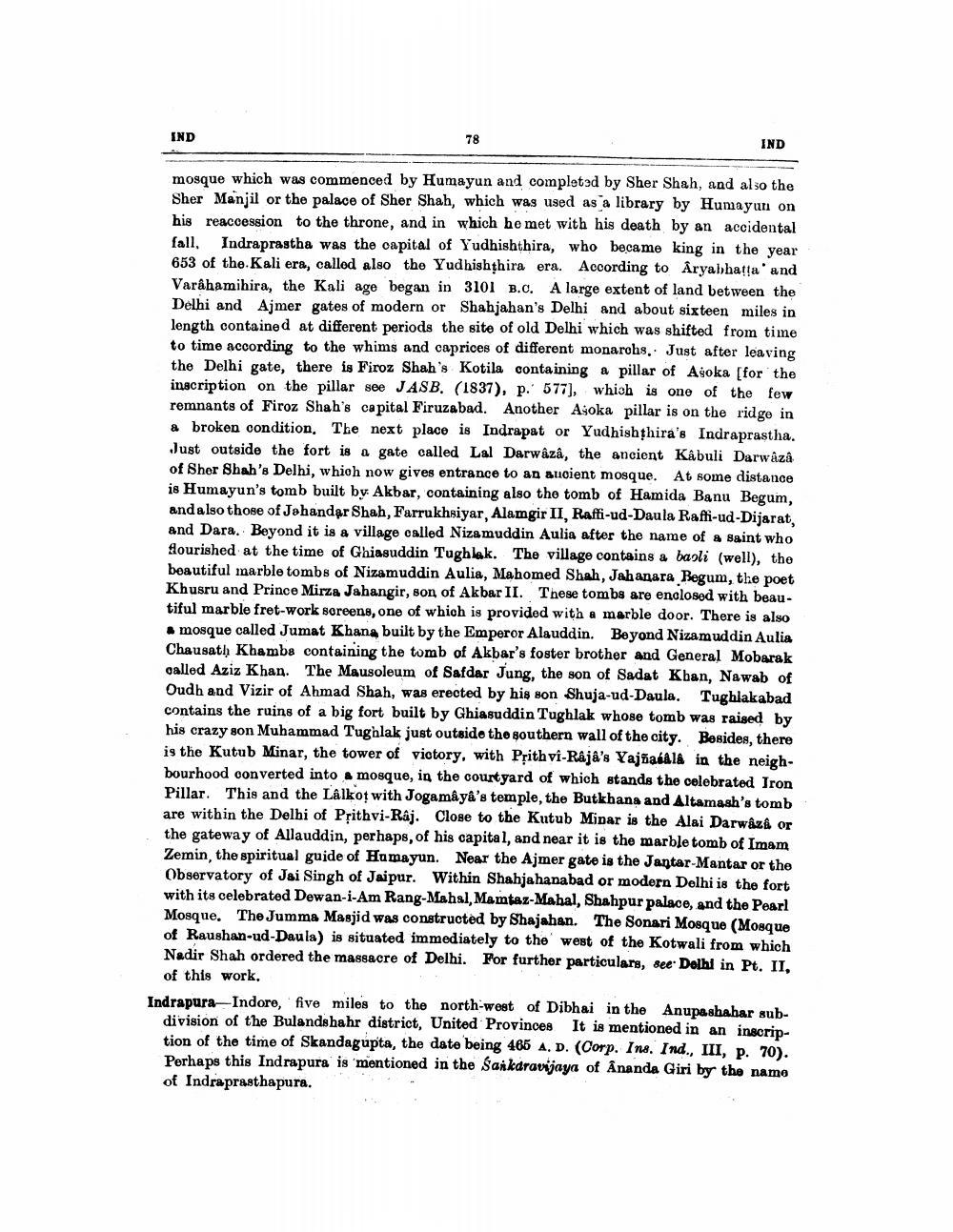________________
IND
78
IND
mosque which was commenced by Humayun and completed by Sher Shah, and also the Sher Manjil or the palace of Sher Shah, which was used as a library by Humayun on his reaccession to the throne, and in which he met with his death by an accidental fall, Indraprastha was the capital of Yudhishthira, who became king in the year 653 of the Kali era, called also the Yudhishthira era. According to Aryabhatta' and Varahamihira, the Kali age began in 3101 B.C. A large extent of land between the Delhi and Ajmer gates of modern or Shahjahan's Delhi and about sixteen miles in length contained at different periods the site of old Delhi which was shifted from time to time according to the whims and caprices of different monarobs.. Just after leaving the Delhi gate, there is Firoz Shah's Kotila containing a pillar of Ajoka [for the inscription on the pillar see JASB. (1837), p. 577], which is one of the few remnants of Firoz Shah's capital Firuzabad. Another Ajoka pillar is on the ridge in a broken condition. The next place is Indrapat or Yudhishthira's Indraprastha. Just outside the fort is a gate called Lal Darwâzâ, the ancient Kabuli Darwâzâ of Sher Shah's Delhi, which now gives entrance to an ancient mosque. At some distance is Humayun's tomb built by Akbar, containing also the tomb of Hamida Banu Begum. and also those of Jehandar Shah, Farrukhsiyar, Alamgir II, Raffi-ud-Daula Raffi-ud-Dijarat, and Dara. Beyond it is a village called Nizamuddin Aulia after the name of a saint who Nourished at the time of Ghiasuddin Tughlak. The village contains a baoli (well), the beautiful marble tombs of Nizamuddin Aulia, Mahomed Shah, Jahanara Begum, the poet Khusru and Prince Mirza Jahangir, son of Akbar II. These tombs are enclosed with beautiful marble fret-work soreens, one of which is provided with a marble door. There is also . mosque called Jumat Khans built by the Emperor Alauddin. Beyond Nizamuddin Aulia Chausath Khambs containing the tomb of Akbar's foster brother and General Mobarak called Aziz Khan. The Mausoleum of Safdar Jung, the son of Sadat Khan, Nawab of Oudh and Vizir of Ahmad Shah, was erected by his son Shuja-ud-Daula. Tughlakabad contains the ruins of a big fort built by Ghiasuddin Tughlak whose tomb was raised by his crazy son Muhammad Tughlak just outside the southern wall of the city. Besides, there is the Kutub Minar, the tower of victory, with Prithvi-Raja's Yajšalala in the neighbourhood oonverted into a mosque, in the courtyard of which stands the celebrated Iron Pillar. This and the LÂlkoț with Jogamâyâ's temple, the Butkhana and Altamash's tomb are within the Delhi of Prithvi-Raj. Close to the Kutub Minar is the Alai Darwaza or the gateway of Allauddin, perhaps, of his capital, and near it is the marble tomb of Imam Zemin, the spiritual guide of Humayun. Near the Ajmer gate is the Jantar Mantar or the Observatory of Jai Singh of Jaipur. Within Shahjahanabad or modern Delhi is the fort with its celebrated Dewan-i-Am Rang-Mahal, Mamtaz-Mahal, Shahpur palace, and the Pearl Mosque. The Jumma Masjid was constructed by Shajahan. The Sonari Mosque (Mosque of Raushan-ud-Daula) is situated immediately to the west of the Kotwali from which Nadir Shah ordered the massacre of Delhi. For further particulars, see. Dolhi in Pt. II, of this work. Indrapura Indore, five miles to the north-west of Dibhai in the Anupashahar sub
division of the Bulandshahr district, United Provinces It is mentioned in an inscription of the time of Skandagupta, the date being 466 A.D. (Corp. Ins. Ind., III, p. 70). Perhaps this Indrapura is mentioned in the Sankdravijaya of Ananda Giri by the namo of Indraprasthapura.




